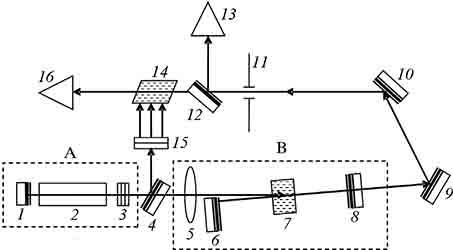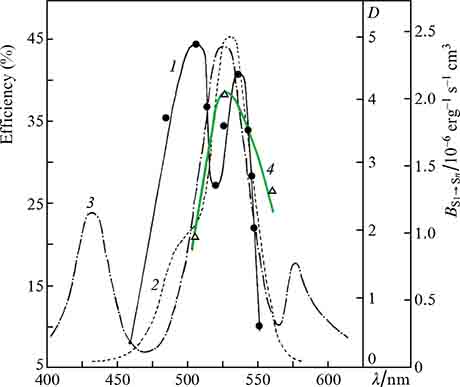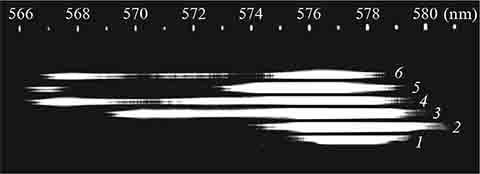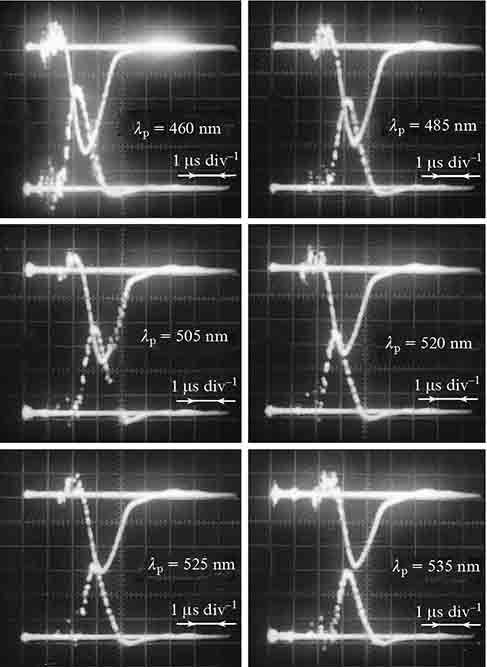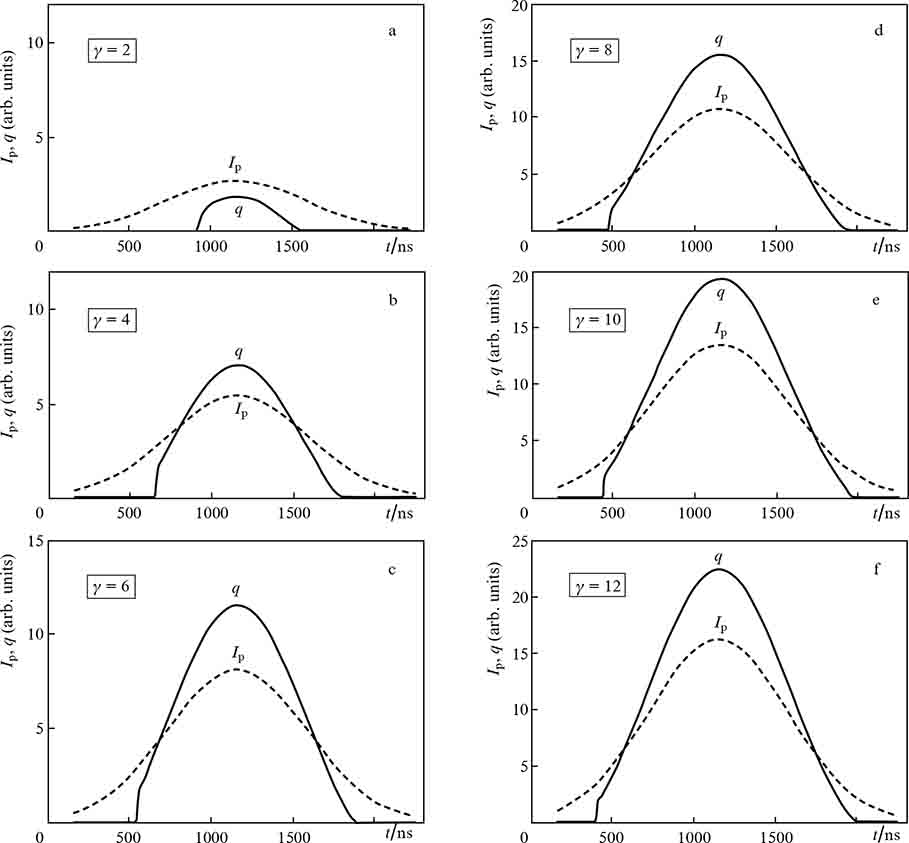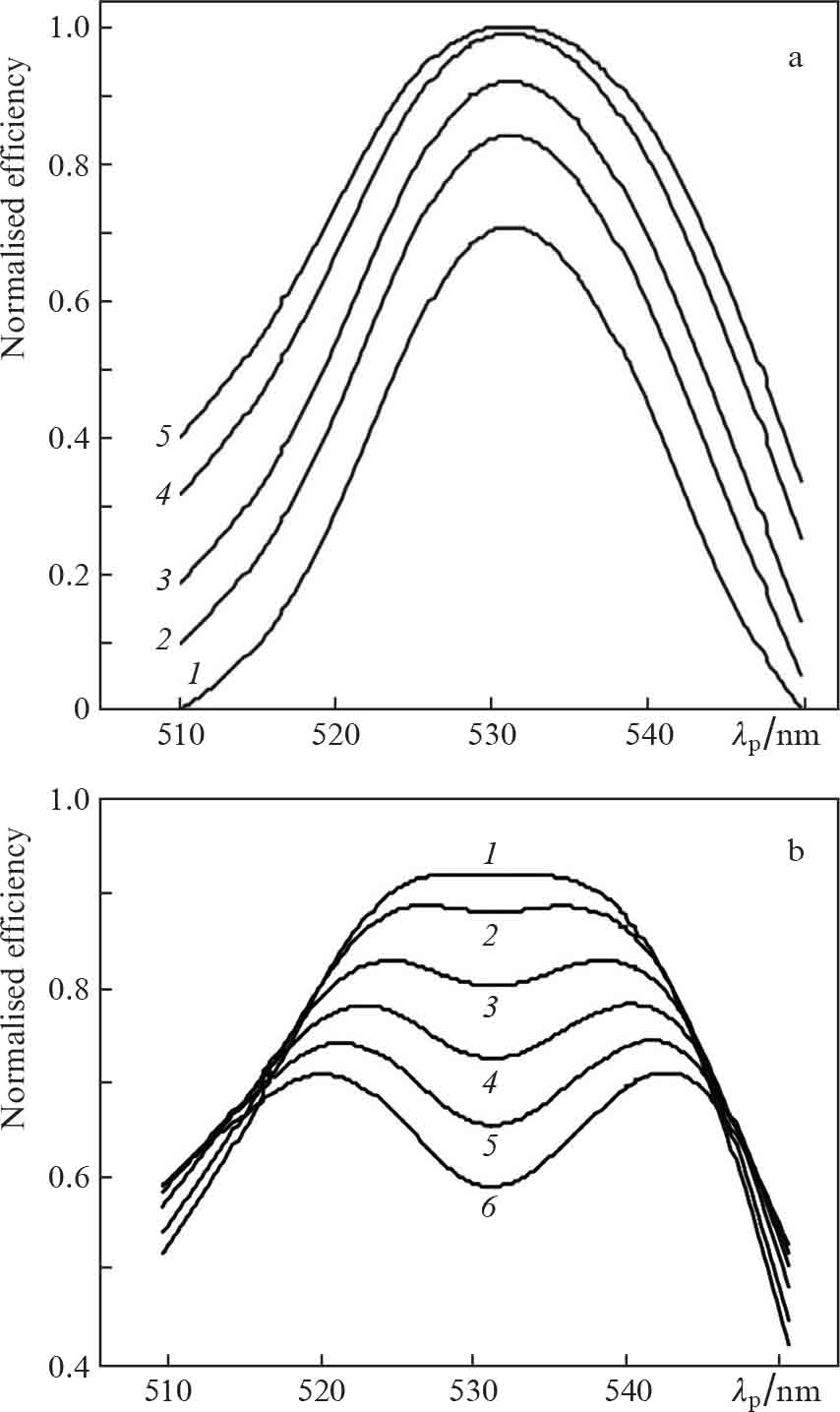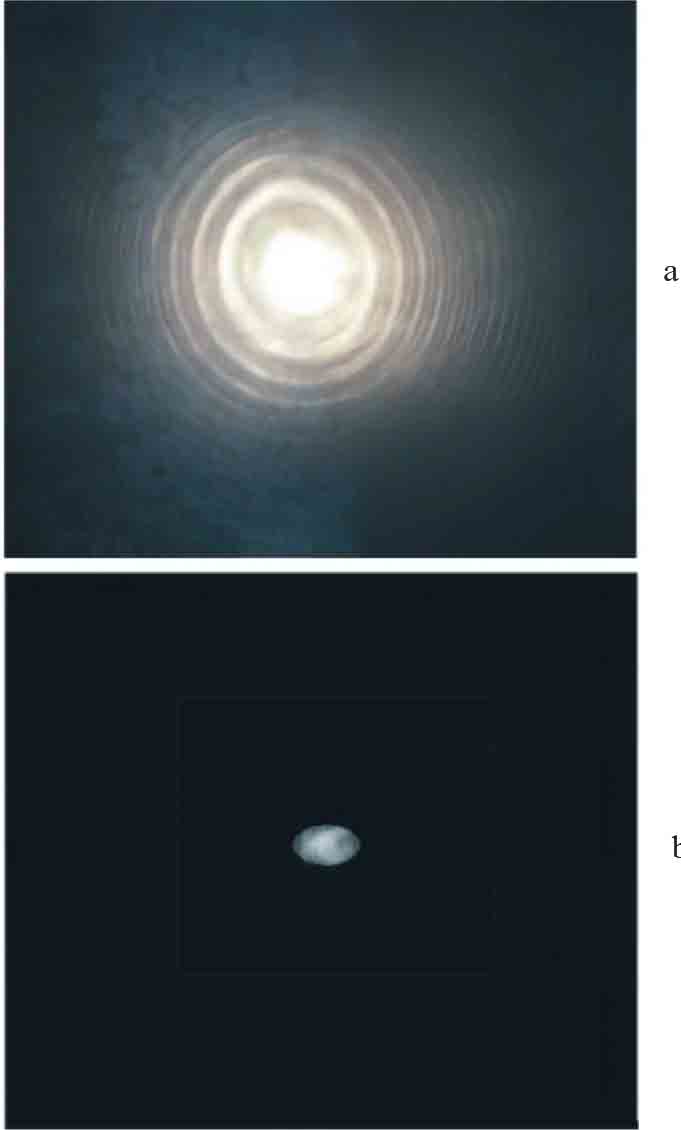Abstract
We examine the effect of the pump-induced loss in the gain medium of a Rhodamine 6G laser on the spectral dependence of the laser efficiency under microsecond coherent pumping. It is shown theoretically and experimentally that the pump-induced loss is mainly due to nonlinear refraction and thermo-optic inhomogeneities of the gain medium, which produce a negative thermal lens, whose defocusing effect reduces the laser efficiency. The induced absorption by excited-state singlet and triplet levels of dye molecules is shown to make no significant contribution to changes in laser efficiency. The pump-induced thermal loss at the peak absorption wavelength of Rhodamine 6G plays a more important role well above the threshold pump power density (γ ⩾ 5). We demonstrate that the maximum dye laser efficiency under microsecond coherent pumping can only be achieved at an optimal pump wavelength.
Export citation and abstract BibTeX RIS
1. Introduction
Dye lasers (DLs) generating microsecond light pulses are used in various areas of science and technology. These are either lamp-pumped lasers or coherently pumped two-stage converter lasers [1, 2]. The inherent drawbacks of the former lasers include a large beam divergence and losses due to photodestruction of dye molecules and triplet – triplet absorption. The two-stage dye-solution converter lasers offer a beam divergence of ∼1 mrad owing to the extremely low Stokes loss and the absence of UV and IR components in their pump spectrum. Besides, such a system has a considerably increased service life of the dye in the second-stage laser [1, 2]. The use of a master oscillator with two-step excitation and amplifiers based on such an excitation scheme allows one to obtain wavelength-tunable ∼1-μs light pulses with a divergence of ∼10−3 rad, spectral width of ∼10−3 nm, and energy of ∼0.5 J [3].
Dye lasers generating microsecond light pulses with such characteristics hold the most promise for use in art holography systems. This is related to the requirements for the laser pulse duration, which should correspond, on the one hand, to characteristics of photographic materials and, on the other, to characteristic rates of variations in the surface structure of objects being photographed, which reduce the contrast of holograms. In particular, estimates show that portrait holography requires ∼1-μs light pulses [4].
In addition, such lasers are used in spectroscopy, nonlinear optics, photochemistry, biology, and medicine. For example, DLs pumped by microsecond flashlamp pulses have found wide application in intracorporeal lithotripsy. Medical systems based on such lasers are designed and manufactured by a number of companies in Europe and the United States [5, 6]. Advantages of such lasers include selectivity and the fact that microsecond light pulses do not destroy optical fibre, unlike in the case of nanosecond pulses, where fragments of the optical fibre and polymer coating can be left in the ureter after a standard lithotripsy session.
Previous work has demonstrated that, in the case of some dyes and coherent nanosecond pumping, laser efficiency varies anomalously with excitation wavelength [7 – 9]. Such results have been obtained for a number of organic dyes [POPOP (1,4-bis[2-(5-phenyloxazolyl)]benzene), coumarin 120, perylene, and naphtalimides] [7, 10]. It follows from those results that pumping at the centre wavelength of the absorption band of a dye is not optimal. Some authors reported that the pump-induced loss due to the absorption by excited-state triplet [11] and singlet [12] levels had a significant influence on experimentally observed effects. In contrast, others reported that this type of loss had a relatively weak effect on the variation of laser efficiency with pump wavelength [13].
In this paper, we report a study of the effect of induced absorption and pump-induced thermal inhomogeneities in the gain medium on the laser efficiency of a Rhodamine 6G solution in ethanol under pumping with microsecond DL pulses [14, 15].
2. Experimental setup and measurement technique
In our experiments, we used a dye-solution converter laser with two-step excitation and a system for measuring output energetic and spectral characteristics (Fig. 1) [1, 2].
Figure 1. Schematic of the experimental setup:(A) first-stage dye laser pumped by a coaxial cuvette lamp; (B) second-stage dye laser; (1, 6) highly reflective mirrors; (2) coaxial cuvette lamp; (3) output mirror of the lamp-pumped dye laser (stack of three plane-parallel plates); (4, 9, 10, 12) scanning mirrors; (5) focusing lens; (7) gain medium (Rhodamine 6G solution in ethanol); (8) output mirror of the second-stage dye laser; (11) diaphragm; (13, 16) IMO-2N meters; (14) cuvette containing the Rhodamine 6G solution in ethanol; (15) cylindrical lens.
Download figure:
Standard imageThe pump source for the first-stage laser (A) was a Dzyubenko coaxial lamp 8 mm in inner diameter and 250 mm in length [2, 16]. The DL cavity was formed by a flat dielectric mirror (R = 100 %) and a stack of three plane-parallel K8 glass plates – an optimal output mirror.
The discharge circuit included 12 parallel-connected K75-48 low-inductance capacitors with a total capacitance of 2.64 μF and an IRT-6 ignitron discharger. The power supply voltage was 18 kV. The discharge gap of the lamp was filled with xenon to a pressure of 20 – 30 Torr. The pump pulse full width at half maximum was 2 μs, with a 0.8-μs leading edge. The electrical pump pulse energy was ∼430 J.
The cavity of the second-stage converter laser was formed by a flat mirror highly reflective in the range λ = 510 – 610 nm and a flat output mirror with R = 60 % in the range 490 – 565 nm. The second-stage laser was pumped quasi-longitudinally.
The gain media in laser A were 1.2 × 10−4 M coumarin 30 (λg = 505 nm), coumarin 7 (λg = 525 nm), and coumarin 6 (λg = 540 nm) dye solutions in ethanol. Light at these wavelengths was used, first, for pumping the second-stage Rhodamine 6G laser and, second, for pumping a Rhodamine 6G solution in a cuvette (14) (Fig. 1) in the regions of both the lowest laser efficiency (dip) and the highest efficiency of the gain medium.
The output of laser B was used to probe the Rhodamine 6G solution in ethanol in cuvette 14 in the gain region under pumping at the wavelengths indicated above and without pumping. As was assumed previously [14, 15], it is in the gain region of Rhodamine 6G that pump absorption in a system of excited state singlet levels can lead to the formation of reversible photoproducts which impair laser efficiency. To match the probe beam and cuvette (14) apertures, we used a 7-mm-diameter Teflon diaphragm (11). The Rhodamine 6G concentration in cuvettes 7 and 14 was such that it ensured an absorption coefficient from 15 to 25 cm−1 at the pump wavelength. Such an absorption in typical dyes corresponds to a concentration of 5 × 1016 cm−3 (10−4 mol L−1) [17]. Before experiments, meters 13 and 16 were mutually calibrated to ensure accurate measurements of the energy of the probe beam incident on the sample.
3. Experimental results and discussion
3.1. Effect of the optical loss in the channel of excited-state singlet levels on laser efficiency
As shown earlier [14, 15], at pump wavelengths within the main absorption band of various classes of dyes, the efficiency and spectral characteristics of lasing vary anomalously with pump wavelength: with increasing pump wavelength, the efficiency first rises, then drops near the peak absorption wavelength of the dye, and rises again on the long-wavelength side of its absorption band. The corresponding dependence for Rhodamine 6G is represented by curve (1) in Fig. 2. Also shown in Fig. 2 are the optical density spectrum of the Rhodamine 6G solution in ethanol [curve (2)], an analogous spectrum measured under high-power pumping [curve (4)], and the spectrum of the Einstein coefficient BS1 → Sn for the absorption by excited-state singlet levels, obtained from previously reported experimental data [18, 19].
Figure 2. (1) Laser efficiency as a function of pump wavelength for the Rhodamine 6G solution in ethanol, (2) spectrum of the main absorption band of Rhodamine 6G, (3) spectrum of the Einstein coefficient BS1 → Sn for the absorption by excited-state singlet levels of the Rhodamine 6G solution, and (4) measured optical density spectrum of the Rhodamine 6G solution in ethanol in the gain region under high-power pumping.
Download figure:
Standard imageWith increasing pump wavelength (Fig. 3), the gain band extends to shorter wavelengths by 10 – 12 nm and dual-wavelength lasing is observed around the dip. The shift of the lasing spectrum to shorter wavelengths attests to an increase in wavelength-dependent optical loss [17]. Besides, such effects were shown to occur in solid-state systems as well, in particular in a two-stage dye-solution converter laser in solid matrices based on a nanoporous glass/polymer composite [20].
Figure 3. Lasing spectra of the Rhodamine 6G solution in ethanol at pump wavelengths of (1) 460, (2) 485, (3) 505, (4) 520, (5) 525, and (6) 535 nm.
Download figure:
Standard imageTo assess the possible effect of the optical loss due to the absorption by excited-state triplet levels on laser efficiency, we examined how the time variation of pump and laser pulses depended on the spectral composition of pump light (Fig. 4). In none of the cases under consideration was additional time-dependent loss detected during lasing, i.e. the loss due to the absorption of laser light by excited-state triplet levels of molecules played a secondary role in comparison with the loss due to the absorption by excited-state singlet levels. It is known from the literature that the highest laser efficiency in a Rhodamine 6G solution in ethanol under pumping by nanosecond pulses at λp = 530 nm can be reached at an incident power density in the range 20 – 40 MW cm−2 and that, under the optimal conditions, the efficiency is determined by the pump and laser output losses due to the absorption by excited-state singlet levels [21].
Figure 4. Pump (upper) and laser (lower) pulses of the Rhodamine 6G solution in ethanol at a varied spectral composition of pump light.
Download figure:
Standard imageComparison of the experimental data obtained using microsecond pump pulses with results for nanosecond pumping shows that the efficiency obtained at optimal energy densities in the case of ∼1-μs pump pulses (∼40 %) differs little from that in the case of nanosecond pumping at the corresponding energy densities.
To find out how the optical loss due to the absorption by excited-state singlet levels influenced laser efficiency, the Rhodamine 6G solution in ethanol was probed in the gain region of the dye (λ = 570 nm) after pumping the solution in spectral ranges around 505 (the first peak in laser efficiency), 525 (lowest laser efficiency), and 540 nm (second peak in laser efficiency). The optical density of the solution under study was measured as described above.
The following results were obtained in our experiments: Without pumping, the probe light at λ = 570 nm was absorbed (D ≈ 0.4). Under pumping near the first efficiency peak (λ = 505 nm), the probe signal at the outlet of the cuvette was amplified by 15 % to 19 %, which was due to the population inversion of the laser levels under pumping.
After pumping around the minimum in efficiency (λp = 525 nm), no probe signal amplification was detected. In contrast, 10 % to 12 % of the probe signal was absorbed.
After pumping around the second efficiency peak (λp = 540 nm), the probe signal was slightly amplified (by ∼2 %). The low value of the gain in this case was most likely the result of the loss due to the overlap of the long-wavelength part of the absorption profile with the short-wavelength part of the fluorescence spectrum.
Thus, the present experimental data lend support to the conclusion drawn previously [14, 15] that, in the case of microsecond coherent pumping of dye solutions, pump absorption leads to the formation of long-lived photoproducts (τ > 25 ns) strongly absorbing in the spectral region of amplification [21 – 23]. To account for the effect of the loss on Rhodamine 6G laser efficiency, attention should be paid to the shape of the spectrum of the Einstein coefficient BS1 → Sn for the absorption by excited-state singlet levels (Fig. 2): the maximum of the spectrum coincides with the minimum in Rhodamine 6G laser efficiency.
3.2. Effect of pump-induced thermal inhomogeneities in the gain medium on laser efficiency
As mentioned above, a number of effects in the gain medium of DLs can be taken into account for interpreting the present experimental data: T – T absorption, loss due to the absorption by singlet levels, pump-induced thermal inhomogeneity, and interaction of the laser output with the pump-induced dye photodestruction products [24, 25].
The loss coefficient of laser light, important for evaluating the efficiency of a coherently pumped dye laser, is directly related to beam divergence. The laser beam divergence increases as a result of pump-induced thermal defocusing. (A typical pump energy loss during dye laser operation is ∼50 %, and all this energy eventually goes to heating the gain medium, changing its refractive index.)
According to a rate equation analysis of DL kinetics under microsecond pumping [26], T – T absorption has an extremely weak impact on the effect under investigation. At the same time, electron excitation energy relaxation in higher excited singlet states was assumed to play a rather important role. A considerable contribution to this effect can be made by an induced S – S absorption, whose spectral maximum corresponds to the conventional absorption maximum [18].
Figure 5 shows an energy level diagram that allows one to describe processes in the DL with allowance for the induced absorption by S – S and T – T energy levels. In evaluating laser efficiency as a function of microsecond monochromatic pump wavelength, we took into account the spectral dependences of the absorption cross section of the S0 – S1 levels, σ0S(λ), and the absorption cross section of the S1 – S2 levels, σSS(λ). The effect of the spectral dependence of the T – T absorption and related loss is taken into account by the absorption cross section σTT(λ).
Figure 5. Dye energy level diagram used in our calculations: S0, S1, and S2 are singlet energy levels; T1 and T2 are triplet energy levels; the coefficients dij are nonradiative transition probabilities; and the coefficients Pij are intercombination conversion probabilities.
Download figure:
Standard imageThe system of equations describing DL operation with allowance for the above processes has the following form:
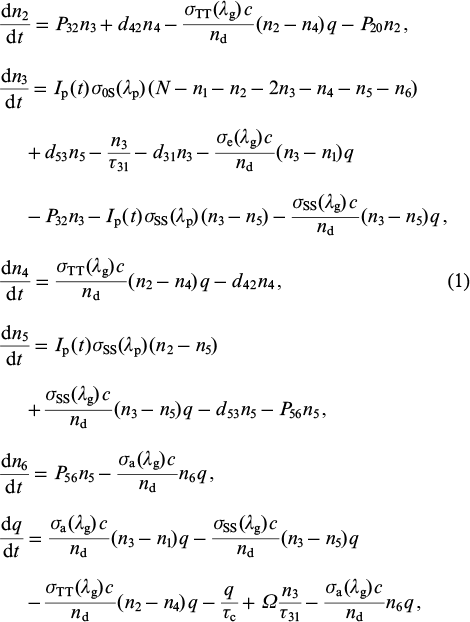
where

is the photon lifetime in the cavity; l is the cavity base length; R1 and R2 are the reflectivities of the mirrors; the coefficient Ω = πb2/(16Kl2) characterises the relative part of spontaneous emission propagating in the lasing channel; b is the cross-sectional size of the pump beam; the coefficient K takes into account the fraction of spontaneous emission in the laser output; N is the concentration of dye molecules; ni is the concentration of particles in the corresponding excited states; q is the volumetric density of emitted photons at wavelength λg; σe (λg) is the stimulated emission cross section; σa (λg) is the absorption cross section of a higher excited singlet state; the coefficients dij are responsible for nonradiative relaxation of state i through an i – j transition; the coefficients Pij are responsible for intercombination conversion of state i through this transition; τ31 is the radiative lifetime of the upper laser level; nd is the refractive index of the dye solution; Ip is pump intensity; and TΣ is the total round-trip cavity loss.
The laser spot diameter d on the output mirror is proportional to the beam divergence θ, and the spot area S is proportional to the square of the divergence. Since the optical loss coefficient Tloss is proportional to S, we have

Taking the minimum beam divergence to be the diffraction-limited one, we obtain for the minimum output laser spot

We define the single-pass beam divergence at the output of the active laser medium as the divergence of a Gaussian beam subjected to thermal defocusing according to the equation [27]

where

is the length related to nonlinear laser beam refraction; f is the normalised width of the Gaussian beam; β is the gain coefficient; Rdif = ka2/2 is the characteristic length related to beam diffraction; k is the wavenumber; a is the laser beam radius; k is the thermal conductivity of the gain medium; ε is its dielectric permittivity; T is the absolute temperature; and x is a coordinate along the laser beam axis.
A numerical analysis indicates that, in the case of quasi-steady-state lasing, the gain coefficient β is constant and, hence, β in Eqn (4) does not vary.
Calculations using Eqn (4) show that, at constant gain medium parameters, the beam divergence increases linearly with pump power:

Here ΔP = P – Pth, where P is the pump power and Pth is the threshold pump power. In (5), the minimum divergence for our case is 0.94 mrad and the coefficient α = Δθ/ΔP is 0.82 mrad W−1. From the above results, we can find the loss coefficient using relation (2):

where γ = P/Pth.
To identify the main mechanism determining the effect of pump wavelength on laser efficiency, a detailed theoretical analysis with the use of computer simulation based on an elaborate model is necessary.
In modelling a DL excited by microsecond pulses, we used parameters of the Rhodamine 6G laser dye, which is often employed in experimental studies: σe = 2.16 × 10−16 cm2, τ31 = 5.9 ns, λg = 5.6 × 10−5 cm, nd = 1.36, N = 1.2 × 1017 cm−3, σ0S = 4 × 10−16 cm2 (at the maximum of the S0 → S1 absorption band), σTT = 5 ×10−17 cm2 (at the maximum of the T – T absorption band), σSS = 1.75 × 10−16 cm2 (at the maximum of the S1 → S2 absorption band), l = 20 cm, P32 = 4.2 ×105 s−1, d10 = 5 ×1010 s−1, d31 = 107 s−1, d53 = 2 ×1010 s−1, d42 = 5 ×106 s−1, P20 = 2 ×105 s−1, b = 0.5 cm, K = 10, R1 = 1, and R2 = 0.6.
The spectral dependences of absorption, induced absorption, and stimulated emission cross sections used in our calculations were obtained by interpolating available data [24, 25, 28 – 31].
A theoretical analysis of the effect of pumping level γ on lasing kinetics shows that the peak positions of pump and laser pulses coincide and that the laser pulse power and duration increase with γ (Fig. 6). It is seen from Fig. 6 that, with increasing pumping level, the laser pulse duration increases symmetrically with respect to the peak position, in good agreement with experimental data. At γ = 8, a laser pulse lags the leading edge of the corresponding pump pulse by ∼0.5 μs and the time it takes to reach quasi-steady-state lasing is about 0.1 μs (Fig. 6d).
Figure 6. Dye laser kinetics at a microsecond pump pulse duration and different exceedances of threshold γ (q is the volumetric density of emitted photons).
Download figure:
Standard imageIn examining DL efficiency as a function of microsecond pump wavelength, it should be taken into account that a change in pump absorption in response to pump wavelength tuning will lead to a corresponding change in threshold pump power density. Since this parameter varies, it is reasonable to assess the effect of γ on laser efficiency at a constant pump wavelength. Such data are presented in Fig. 7a. The fact that the efficiency has a maximum at γ = 5 and then gradually decreases suggests that there is a loss which rises considerably with pump power density. This is the part of pump energy which is converted into heat during laser operation and leads to thermo-optic distortion of the cavity in the form of a negative lens, whose optical power increases with pump power density [32].
Figure 7. (a) Calculated laser efficiency normalised to the maximum value vs. pump power normalised to the threshold value and (b) experimentally determined laser efficiency vs. pump energy density W at a pump pulse duration of (1) 1, (2) 2, and (3) 5 μs and a pump wavelength λp = 532 nm.
Download figure:
Standard imageThe thermal loss of energy in the gain medium is proportional to the difference between the pump and laser output energies and its effect becomes significant when the pump energy exceeds some level, Emin, determined for particular laser operation conditions. In such a case, the pump-induced negative thermal lens considerably increases the laser beam divergence. Further increase in the defocusing effect of the thermal lens eventually leads to a reduction in efficiency with increasing pump energy (Fig. 7a).
Figure 7b illustrates the experimentally observed effect of microsecond pump energy density on laser efficiency. The highest efficiency was reached at an energy density of 2 J cm−2, whereas the threshold pump energy density was 0.5 J cm−2, which corresponded to γ = 4, in good agreement with the calculated γ = 5.
Figure 8 shows the calculated laser efficiency as a function of pump wavelength at various normalised pumping levels. The corresponding experimental data are represented by curve (1) in Fig. 2.
Figure 8. Calculated laser efficiency normalised to the maximum value vs. pump wavelength at (a) γ = (1) 2, (2) 2.5, (3) 3, (4) 4, and (5) 5 and (b) γ = (1) 8, (2) 9, (3) 11, (4) 13, (5) 15, and (6) 17.
Download figure:
Standard imageFor γ ⩽ 5 (Fig. 8a), the laser efficiency as a function of pump wavelength has one maximum. To higher pumping levels there corresponds higher efficiency. In this case, the loss coefficient is relatively small because of the effect of thermal lensing. For γ > 8, the way in which laser efficiency varies with pump wavelength changes. As seen from Fig. 8b, increasing the pump power leads to a decrease in efficiency [curves (2) – (6)]. In this case, a dip is formed near the peak absorption wavelength and increases with pump power [curves (3) – (6)]. The thermal lensing-induced loss coefficient is here rather large. It reaches the highest value at the peak absorption wavelength of the dye because at this wavelength the largest fraction of the absorbed energy goes to thermo-optic distortion of the gain medium. The calculation results are well supported by the experimental data presented in Fig. 2 [curve (1)], which clearly shows a dip in Rhodamine 6G laser efficiency under pumping at λp = 530 nm.
Experimental evidence for thermo-optic distortion and the formation of a negative lens in the Rhodamine 6G solution in ethanol under microsecond pumping is presented in Fig. 9a, which shows a photograph of the far-field spatial intensity distribution under pumping at λp = 525 nm, near the minimum in laser output energy (γ = 8). It is clearly seen that there is an interference pattern in the form of concentric circles, due to the thermal lensing in the solution. To the observed picture there corresponds an angular divergence θ ≈ 10−3 rad. For comparison, Fig. 9b shows a spatial laser output intensity distribution under nanosecond pumping (λp = 532 nm). Comparison demonstrates significant differences in the structure and size of spots and, accordingly, a smaller angular divergence in the case of nanosecond pumping.
Figure 9. Photographs of far-field spatial laser intensity distributions for the Rhodamine 6G solution in ethanol under (a) microsecond pumping at λp = 525 nm and (b) nanosecond pumping at λp = 532 nm.
Download figure:
Standard imageIt is worth noting that pump-induced thermal lensing is not the only cause of the decrease in laser efficiency as a function of pump wavelength of various dyes, because experimentally observed dips were located not at the centre of their absorption bands. Dips in the spectral dependence of laser efficiency were located both in the centre of the absorption bands and on their short- or long-wavelength wings [14, 15, 23]. To understand this, it should be taken into account that the spectral absorption and fluorescence profiles of the dye are inhomogeneously broadened. Under high-power monochromatic pumping, the absorption and gain profiles undergo a certain transformation due to the corresponding changes in the population of energy states. We are thus led to conclude that the position of the dips is mainly determined by the overall effect of two effects considered in this study: nonlinear refraction and relaxation processes in the system of singlet levels.
A numerical analysis of the influence of induced absorption and the corresponding loss in the channel of higher singlet levels shows that this loss is relatively small because of the small population of the corresponding energy states. The relative population of the S2 state is ∼10−6, and its lifetime is a few picoseconds.
4. Conclusions
It is shown that the presence of a dip in the Rhodamine 6G laser efficiency as a function of pump wavelength is caused by nonlinear refraction in the gain medium, which produces thermo-optical distortion, leading to the formation of a negative lens and laser beam defocusing. At the same time, induced absorption by the S1 – S2 and T – T levels of dye molecules has no significant effect on the behaviour of the laser efficiency.
The pump-induced thermal loss under pumping at the peak absorption wavelength of Rhodamine 6G plays a more important role well above the threshold pump power density (γ ⩾ 5).
The present results suggest that, to achieve a high Rhodamine 6G laser efficiency, it is necessary to use a pump wavelength λp = 500 nm, which maximises the laser efficiency (at least 45%). Pumping around the peak absorption wavelength of the dye (525 – 530 nm) is not optimal because the laser efficiency decreases in this spectral range.
Taking into account the processes in question will make it possible to optimise the spectral range for diode pumping of various dyes and improve the efficiency and performance stability of microsecond and nanosecond dye laser systems.



